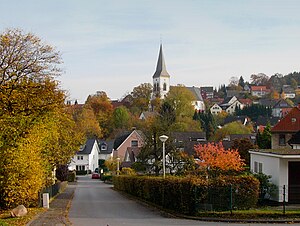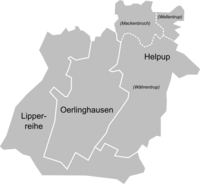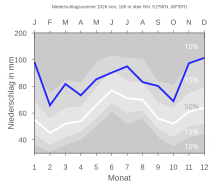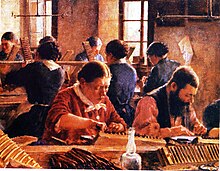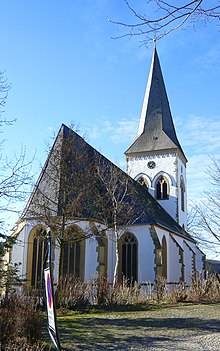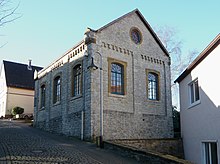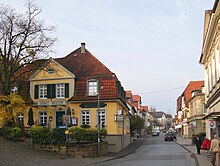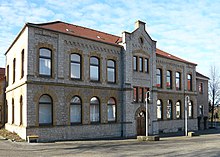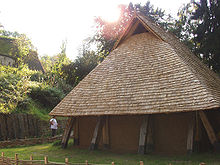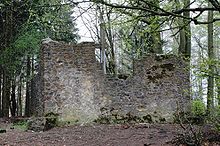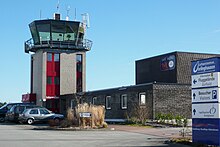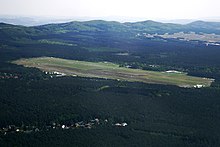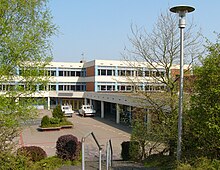Oerlinghausen
| coat of arms | Germany map | |
|---|---|---|

|
Coordinates: 51 ° 58 ′ N , 8 ° 40 ′ E |
|
| Basic data | ||
| State : | North Rhine-Westphalia | |
| Administrative region : | Detmold | |
| Circle : | lip | |
| Height : | 214 m above sea level NHN | |
| Area : | 32.69 km 2 | |
| Residents: | 17,142 (Dec. 31, 2019) | |
| Population density : | 524 inhabitants per km 2 | |
| Postal code : | 33813 | |
| Area code : | 05202 | |
| License plate : | LIP | |
| Community key : | 05 7 66 056 | |
| LOCODE : | DE OEN | |
| City structure: | 3 districts | |
City administration address : |
Rathausplatz 1 33813 Oerlinghausen |
|
| Website : | ||
| Mayor : | Dirk Becker ( SPD ) | |
| Location of the city of Oerlinghausen in the Lippe district | ||
Oerlinghausen [ ˈœʁlɪŋhaʊzən ] ( Ankhiusen in Low German ) is a city in the Lippe district in northeast North Rhine-Westphalia . It is located southeast of Bielefeld on a pass over the Teutoburg Forest .
With around 17,000 inhabitants, Oerlinghausen is the fifth largest city in the Lippe district . The Oerlinghausen glider airfield is one of the two largest of its kind in Europe and, along with the archaeological open - air museum, has made the city known nationwide. In the past the linen and cigar industry was leading, today Oerlinghausen benefits from its proximity to Bielefeld. Many commuters drive to the neighboring city; some Bielefeld companies have now set up production facilities in Oerlinghausen.
The city in its current boundaries was only created on January 1, 1969 by amalgamating the city of Oerlinghausen with the previously independent municipalities of Lipperreihe and Helpup . The first settlement of today's urban area can be traced back to 400 to 50 BC. To date to BC ; The place is first mentioned in documents as Orlinchusen in 1036 .
geography
Geographical location
The city of Oerlinghausen is located in the west of the Lippe district, in the east of North Rhine-Westphalia. It is located on a pass over the Teutoburg Forest ridge , roughly halfway between Bielefeld (11 kilometers to the west) and Detmold (15 kilometers to the east) within the Teutoburg Forest / Eggegebirge nature reserve . The core town is mainly on the northern slope of the Tönsberg , as is the district of Währentrup . The districts of Südstadt and Lipperzeile can be found in the plain south of the Teutoburg Forest, the district of Helpup to the north of it, and the ridge itself is part of the Weser-Ems watershed at this point . The Kumsttonne on the Tönsberg is the landmark of Oerlinghausen. The former name Osning for the ridge means holy forest ridge and the term Teutoburg Forest has only been used for around 200 years, which is said to come from the Roman historian Tacitus .
The highest point in the city is at 334 m above sea level. NN (Tönsberg), the lowest at about 120 m above sea level. NN at the outflow of the Sieksbach on the northern outskirts in Helpup.
geology
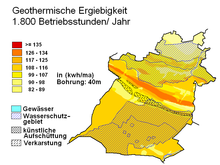
Due to its location on both sides of the Teutoburg Forest, Oerlinghausen has a distinctive morphology . In a very narrow space, clay , sand , marl and limestone from the Middle Ages that are steep to the top can be found. In the northeastern municipal area, limestones of the shell limestone predominate, while the southwestern part of the municipality already belongs to the Senne , which was formed when the last ice age melted when the meltwater carried large amounts of sand with it and deposited it here. In some places the deposits are over 60 meters thick and consist of crushed Osning sandstone. The Osningkamm runs through the city center . This elongated mountain range consists of three mountain ranges running from northwest to southeast. The central main ridge is formed by the Osning sandstone of the Lower Cretaceous , the southern ridge consists of Turonium and Cenomanium layers from the Upper Cretaceous and the northern ridge of Keuper and Muschelkalk.
Oerlinghausen is largely well suited in the northern part of the municipality, in the southern part of the municipality consistently well and in ridge locations very well for the use of geothermal heat sources by means of geothermal probes and heat recovery through heat pump heating (see the adjacent map).
Expansion and use of the urban area
The city, classified as a "large rural community", covers an area of 32.7 square kilometers. The extension of the urban area in north-south direction is around seven kilometers, in east-west direction five kilometers. Compared to other communities of the same type, Oerlinghausen has almost twice as high a proportion of forest area. This is due to the location in the Teutoburg Forest.
| Area according to type of use |
Agricultural schafts- area |
Forest area |
Building, open and operational space |
Traffic area |
Surface of water |
Sports and green space |
other use |
|---|---|---|---|---|---|---|---|
| Area in km² | 7.52 | 16.03 | 4.53 | 2.59 | 0.24 | 1.44 | 0.33 |
| Share of total area | 23.0% | 49.0% | 13.9% | 8.0% | 0.7% | 4.4% | 1.0% |
Neighboring communities
Oerlinghausen borders the Bielefeld districts Sennestadt and Stieghorst to the west, the Leopoldshöhe community to the north , the town of Lage to the east, the Augustdorf community to the southeast (all in the Lippe district) and the town of Schloß Holte-Stukenbrock ( Gütersloh district ) to the south .
City structure
According to the main statute of the city of Oerlinghausen, the city is divided into the three districts of Oerlinghausen , Helpup and Lipperzeile . In addition, a distinction is commonly made between other districts:
- In Währentrup , Mack break and Wellentrup is a historically subdivision of the district Helpup .
- Südstadt refers to a large housing estate in the south of the Oerlinghausen district, which was built in the 1960s; In contrast, the city center of the district is also known as Alt-Oerlinghausen .
The following table shows the area and the population of the districts:
| Population figures and area of the city districts 1 | ||||
|---|---|---|---|---|
| District | surface | Residents | Districts of the city of Oerlinghausen | |
| Oerlinghausen | 9.20 km² | 10,975 | ||
| Helpup | 13.46 km² | 4,789 | ||
| Lip line | 10.04 km² | 3,362 | ||
| total | 32.7 km² | 19,126 | ||
climate
Oerlinghausen belongs to the temperate climate zone of Central Europe. It is in the range of the sub-Atlantic maritime climate. The winters are mostly mild under the influence of the Atlantic and the summers are moderately warm. Due to the geographical location in and on both sides of the Teutoburg Forest, the annual average temperatures vary considerably. While temperatures of eight to nine degrees Celsius on average are reached north and south below the ridge, temperatures are up to two degrees Celsius lower with increasing height to the ridge.
Due to the location in the sub-Atlantic maritime climate, a humid climate prevails all year round with relatively evenly distributed rainfall. Overall, the long-term mean at the Oerlinghausen station due to the rain catching effect of the Teutoburg Forest due to incline rain , an average of 1026 millimeters of precipitation per year. This means that there is significantly more precipitation than the German average (700 millimeters).
history
Origin of the place name Oerlinghausen
The place name Oerlinghausen originated before Christianization ; the syllable -ing is a patronymic form of language. This means that the component Oerl was the name of a man whose descendants were called Oerlinge . Accordingly, Oerlinghausen is the place where the Oerlings lived . For the obvious assumption that there is an etymological connection between the name Oerl and the English Earl of the same name , there is currently no linguistic foundation.
The name Oerlinghausen is emphasized on the first syllable (IPA: ˈœʁlɪŋhaʊzən ) and not, as is often used by foreigners and newcomers, on the third syllable.
Tönsberg camp and first documentary mention
The ridge and the pass near Oerlinghausen were of strategic military importance in ancient times. Unmistakable traces of settlement have been uncovered during excavations in the urban area and the nearby local mountain of Oerlinghausen, the Tönsberg . The Tönsberg camp , a height fortification from the earlier Iron Age, was uncovered. This hill fort was expanded further in Carolingian times. A spring deeper on the slope was included to secure the water supply. Using radiocarbon dating , the first settlement can be traced back to 400 to 50 BC. BC and another date from 750 to 1000 AD. New finds of frit pearls from 2010 on a flagstone grave excavated in 1939 date from around AD 700 and 750. According to Karl Banghard, director of the Oerlinghausen open-air museum , they can point to the oldest significant settlement in Lippe with verifiable roots in the early Middle Ages .
For the first time Oerlinghausen is in Busdorf certificate from May 25, 1036 as Vorwerk Orlinchusen the nearby Haupthofs Barkhausen mentioned. In this document, Bishop Meinwerk von Paderborn issued the decree that, among other things, the tithe was to be paid from the Vorwerke Orlinchusen and Meginchusen ( Menkhausen ) to the canonical monastery of Busdorf, which he founded . The first building in the village was probably a castle to secure the pass road over the Osning. Today there is still a field name called "Burghagen", which apparently indicates the location of this castle.
Medieval feuds and reformation
It is controversial when the Archbishop of Paderborn transferred the power of rule to the sovereigns in Lippe. What is certain, however, is that Bernhard II appears in Oerlinghausen as the owner of the former Paderborn sovereign rights in the second half of the 12th century. It is known from 1177 that Bernhard II occupied and fortified Lewenberg , 3 kilometers northwest of Oerlinghausen , an action that led to a conflict with Count Herrmann von Ravensberg . During the Everstein feud (1403 to 1407), Oerlinghausen, like the entire state of Lippe, was occupied and partially devastated by troops of the Duke of Braunschweig . From the year 1409 there is a list of damages in which there is talk of robbery, arson and other acts of violence, especially in the Lippisch-Ravensberg border area. From the Rietberg feud (1556 to 1566) it is recorded that Count Johann von Rietberg attacked the Lippe exclave Lipperode . Count Bernhard VIII counterattacked from the Oerlinghausen area and besieged the town of Rietberg , which was finally subjugated by the Duke of Jülich .
In the 13th century the center of Oerlinghausen was formed around the Alexander Church. The church is mentioned as early as 1201 and in 1225 a document shows Oerlinghausen as the seat of an archdeaconate . Around 1500 the Antonius chapel was built on the abandoned ridge of the Tönsberg, the ruins of which can be found on the east side of the former fortifications and which gave the mountain its name ("Töns" by Antonius). Shortly before the Reformation, Oerlinghausen was the largest parish in the Diocese of Paderborn , and Oerlinghausen was also the seat of a bailiff , the count's administrative officer. Both, as well as the exposed location on the pass, contributed to the fact that the place developed noticeably, with blacksmiths, wagon builders, shopkeepers and innkeepers settling there.
In 1538 the Lippe state parliament decided to introduce the new Lutheran church order in Lippe. According to the visitors, Oerlinghausen adopted the new church regulations as early as 1540. However, the old clergy remained in office, so that initially almost nothing changed in the service.
Thirty Years War and Absolutism
In the case of villages, unlike cities, there were no walls to protect against enemies and intruders. Instead of stone walls, villages surrounded themselves with a loop , a thorn or hornbeam hedge up to 60 meters wide, through which only a narrow path "winds". The term Landwehr later became established for this type of fortification . The Messdohrschling (Misttorschling) blocked the main access road, Marktstrasse, in Oerlinghausen and was secured at night by a barrier . The citizen responsible for the barrier was called the snake guard . Oerlinghauser residents were obliged to perform night watch duty until the 19th century , when two men armed with halberds patrolled the streets.
Oerlinghausen experienced the first effects of the Thirty Years' War at the end of 1622, when troops were recruited for the alliance of the Catholic imperial estates on Lippe's borders. In the summer of the following year a cavalry unit invaded Oerlinghausen, plundered and devastated the place. The citizens' request for help from Simon VII remained fruitless. The Oerlinghausers suffered several times from billeting soldiers. In 1633 50 riders of the Swedish king invaded the village of Oerlinghausen. The residents had brought their valuables into the church in the hope that the Protestant Swedes would spare their place of worship. That was a fatal error, however, because the mercenaries stole everything that seemed useful to them.
After the devastating war, the power of the territorial rulers grew as the empire lost influence. Louis XIV of France (1638 to 1715) was her model, whom it was important to emulate. Absolutism developed at Lippe's ruling house and reached its climax with Friedrich Adolf (reign: 1697 to 1718) with the lavish development of parks and magnificent buildings. As sensational as these buildings may have been in their time, they had a devastating effect on state finances. Those in charge kept devising new ways of filling the state purse at the expense of the citizens and intervening in the private life of the subjects in ways that are hardly imaginable today. Among other things, it was forbidden to roast and drink coffee as a punishment, as well as to wear black clothing at funeral services and funerals. The denunciation flourished, because who indicated a violation of applicable laws, the adopted one third of its own criminal money.
Age of Enlightenment and Revolution
After the Seven Years' War the population of Oerlinghausen grew like everywhere else in the country. From 1775 to 1824 the population rose from 775 to 1,430 people. In 1774, a post coach line from Bielefeld to Detmold via Oerlinghausen was set up by the Imperial Post Office and a post office was opened.
In Lippe there had been compulsory schooling since 1684 , but many parents rarely or not at all sent their children, who were needed for cattle herding and field work, to school. An instruction from 1722 states that craftsmen could be used to give school lessons in the country. Anyone who knew how to spell difficult words correctly and could sing the most common hymns clearly was suitable for school service - the cane did the rest.
The Lippe school reform in the Age of Enlightenment made the Lippe elementary school system widely known as exemplary. In Oerlinghausen, the further development of the school and educational system is linked to the name of Pastor Georg Conrad von Cölln , who was convinced that a better education for ordinary people would be beneficial for the state. Among other things, the cane was replaced by a laudatory recognition for evidence of a decent life . His brother August von Cölln , as successor in office, continued the work he had started. In 1797 August was called to Detmold as general superintendent by Princess Pauline zur Lippe , where the Oerlinghauser teaching methods were soon adopted.
In March 1848 a group of about 25 young craftspeople had roared through Oerlinghausen and attacked some citizens. Thereupon the Landsturm was alerted, which was supposed to secure Oerlinghausen, but on March 24th could not do anything against a crowd of around a thousand. This had devastated the Niederbarkhausen estate, kidnapped the landlord and his son and led them in a triumphal procession through Oerlinghausen. The next day, a Detmold military detachment appeared and arrested the ringleaders who disappeared behind bars. On March 24, 1848, the Oerlinghauser Revolution was finally called off.
Industrial age and empire
Due to the unfavorable location on the mountain slope, the inhabitants of Oerlinghausen hardly had any land of their own and initially had to earn their living mainly from flax spinning and line weaving . Almost 300 looms were in the Oerlinghausen office. The local weavers were famous for their particularly fine, bleached linen cloth, which was sold by peddlers and hawkers (called "linen hoppers") throughout Germany and neighboring countries. The line hoppers were often out and about for months. The heyday of hand-woven linen came to an end around 1825. When the mechanical looms came to Germany from England , the Oerlinghauser hand weavers were initially competitive thanks to the fine quality of their goods. When the orders failed to materialize, many weaver families suffered from hunger and bitter hardship, and there was also a typhus epidemic . The crisis in linen weaving resulted in Oerlinghausen's population shrinking from 1,710 to 1,510. Many families emigrated to the United States . Thanks to Carl David Weber from Bielefeld, Oerlinghausen linen experienced a new heyday. Although the hand-woven linen was eight times as expensive as the machine-woven material from England, the merchant found enough customers due to the excellent quality of the Oerlinghauser linen. It was not until 1904 that he set up a large mechanical weaving mill in which almost 1,000 people from Oerlinghausen and the surrounding area found work.
In addition to the dominant linen industry, the manufacture of cigars should also be mentioned. Around 1870 there were four cigar factories in Oerlinghausen on Detmolder Strasse that employed up to 120 workers. The beginnings of social democracy in Oerlinghausen had their origins with the cigar makers, who formed their own organization as early as 1861. The authorities were concerned and the bailiff in Schötmar noted with concern that Oerlinghausen was a source of social democracy .
Weimar Republic and National Socialism
In 1926 Oerlinghausen was granted city rights by the Lippe state parliament, which had been sought for four decades.
The NSDAP was completely meaningless in Oerlinghausen before 1930 and even after that the city was considered a “red stronghold” by the National Socialists. Before the state elections in Lippe on January 15, 1933 , the NSDAP started with propaganda that was far superior to that of the other parties. In the final phase of the election campaign, Hitler alone spoke sixteen times in Lippe within ten days, but never directly in Oerlinghausen. In the election, the National Socialists won a majority everywhere in Lippe, except in Oerlinghausen, where the SPD received 1,014 votes and the NSDAP only 751 votes.
In the period that followed, a National Socialist German cult flourished in Oerlinghausen. The main proponent was Hermann Diekmann; He had already undertaken numerous excavations in the 1920s, the results of which, however, had not been scientifically recognized. After the seizure of power, however, he was promoted by the state government; he was appointed headmaster and city councilor. His research on prehistory was now aimed at an idealization of the Teutons, along with the identification of Teutons and National Socialists. In the city, he was entrusted with leading the celebrations for the 900th anniversary.
This ten-day 900th anniversary celebration in 1936 became a prime example of a National Socialist celebration. A play “Oerl Bark, der Sachsenführer”, written especially for the occasion, was performed daily, the radio reported from Oerlinghausen, a pageant through the city was attended by over 25,000 people, a minister and a Reich governor were present, political rallies took place more than 15,000 people. These celebrations as well as the tightly organized preparations for this also contributed in particular to the fact that the National Socialist ideas were consolidated in the population.
In 1933 there were around 25 citizens of Jewish origin in Oerlinghausen , including a doctor and merchants with their families, some of whom had lived in the village for centuries. At the time of the Reichspogromnacht 1938, many Jewish citizens had already left Oerlinghausen; the synagogue was no longer owned by the Jewish community. For unknown reasons, there were no riots during the Reichspogromnacht in Oerlinghausen. It was not until the following night that the NSDAP local group leader and SA people went to the Herz family's business and to the synagogue. The intended destruction could be prevented because the building no longer belonged to the community. However, the tower with the Star of David had to be dismantled in the following days. The remaining citizens of Jewish descent were deported to Riga and Minsk and died there. At the end of 1941 there were no longer any residents of Jewish descent living in the city.
Until shortly before the end of the Second World War , Oerlinghausen was spared immediate combat operations, apart from a few low-flying attacks. In December 1944, the Ju 52 transport aircraft took off from the airfield in Oerlinghausen as part of the Ardennes offensive . In February 1945 a British fighter plane crashed on Tönsberg.
Fighting broke out in the spring of 1945 when, on Easter Sunday, April 1, 1945, the American troops approached from the south and advance units of the 2nd US Panzer Division had taken the communities of Schloß-Holte and Lipperzeile without meeting any resistance bump. In Oerlinghausen, however, a first lieutenant of the Wehrmacht wanted to stop the American advance with a group of Hitler Youths. The Americans had meanwhile positioned their artillery below today's Südstadt, about two to four kilometers south of the Tönsberg.
At 6 p.m. the first shots rang out and some houses went up in flames. A fierce house-to-house battle broke out around the city center, which lasted until April 3. 75 German soldiers, 20 US-American and five citizens of the city were killed. At 7:30 p.m., eyewitnesses report, seemingly endless columns of American tanks rolled through the mountain town. On April 9, 1945, the victims of the fighting around Oerlinghausen were buried.
the post war period
August Reuter , who had been deposed in 1933, was re-elected mayor on April 7, 1945. In the following years the steady influx of new residents made it urgently necessary to create new living space. A large new building area was needed, which the mountain town did not have available. In 1958 the city council decided to build the Südstadt, and the first houses were built there in the early 1960s. From 1961 to 1968 Oerlinghausen grew by 1,800 inhabitants, mainly due to new residents in the southern part of the city.
In 1964, a building complex with 322 residential units was built in Südstadt and the families of the British armed forces stationed in Bielefeld moved into it. At the same time, several houses for the commanders of the British Rhine Army were built on the Hanegge .
The British soldiers left in July 1995, now after the group the settlement, Dieter Conle property with Conle settlement was called. Most of the apartments were occupied by German-Russian resettlers and migrants of various nationalities. The majority were large families from socially disadvantaged backgrounds. The mixture of members of different nationalities and religions led at times to conflicts and increased fluctuation . The question of whether the Conle settlement should be viewed as a social hotspot was controversially discussed by the parties. They looked for possible solutions to promote the integration of young people and to counter the danger of ghetto formation . The AWO district association Lippe e. V. formed a project for open child and youth work in 2000 and opened a children and youth meeting place on the grounds of the settlement.
Religions
Christian communities: Oerlinghausen is one of the oldest parishes in Westlippe. Historians agree that the first church was built here in the early ninth century. In 1538 the Lippe state parliament decided to introduce the new Lutheran church order in Lippe. According to the visitors, Oerlinghausen adopted the new church regulations as early as 1540. However, the old clergy remained in office, so that initially almost nothing changed in the service. In 1607 the Reformed Confession was introduced in Oerlinghausen and the Stukenbrockers were forbidden from attending the Oerlinghauser church service by their Prince-Bishop Dietrich von Fürstenberg . In 1955, the Evangelical Reformed parish comprised 5,700 parishioners, around 85 percent of the total population. The Protestant churches in Oerlinghausen include the Alexander Church in the old town, built in 1514 , the Dietrich-Bonhoeffer-Haus opened in 1973 in the southern part of the city, the 1962 church in Lipperzeile and the church in Helpup, consecrated in 1908. All parishes belong to the Lippe Regional Church of the Evangelical Church in Germany .
After the Reformation there were no Catholics in Oerlinghausen for almost 300 years . Since the First World War , several Catholic families have lived here again, of which the Antonius Chapel was built in Steinbruchstrasse in 1923 . The first pastor was Father Kilian Kirchhoff , who was executed by the National Socialists in 1944. During the Second World War, several hundred Catholic evacuees from the Ruhr area and the Rhineland came to Oerlinghausen and in 1946 many Catholic displaced persons reached the city and increased the Catholic community to 1,100 members in 1952. The collapse of the now much too small Antonius Chapel gave the impetus to build the new St. Michael Church in Marktstrasse, which was inaugurated in 1955. Today the Catholic parish of St. Michael comprises the urban area of Oerlinghausen and the municipality of Leopoldshöhe. The parish has around 2,700 members and is part of the Bielefeld-Lippe deanery in the Archdiocese of Paderborn .
Other Christian communities in Oerlinghausen are the Mennonites in Menno-Simons-Weg, whose members largely consist of immigrant Russian Germans from the CIS countries. Another Mennonite Brethren Congregation exists in the Helpup district. In addition, there is an Adventist congregation and a congregation of the New Apostolic Church .
Jewish community: Until the persecution of the Jews by the National Socialists, there was a small Jewish community in Oerlinghausen . The well-preserved synagogue and the small Jewish cemetery on the ascent to Tönsberg bear witness to this . Some Jewish families had lived in the city for centuries, like those of the textile merchant Siegfried Bornheim, who celebrated his 300th business anniversary in the early 1930s and who emigrated to Uruguay with his daughter and son-in-law in August 1938 . After the war, no more Jewish communities have formed in Oerlinghausen.
The denomination of the pupils in Oerlinghausen can be seen as a reflection of the current distribution of religions. In the 2006/2007 school year, 61.2 percent of the students said they were Protestant, 15.4 percent Catholic and 3.0 percent Islamic as their religious affiliation. 6.6 percent professed another religion and 13.9 percent no religious community.
Incorporations
In 1841 the rural community order in Lippe merged the individual farms into village communities. The village community with the name Senne arose in the Senne , which was renamed Lipperzeile in 1927. On April 1, 1957, the Helpup community emerged from the formerly independent communities of Währentrup, Mackenbruch and parts of the Wellentrup community.
As part of the North Rhine-Westphalian regional reform , the city of Oerlinghausen and the municipalities of Lipperzeile and Helpup were merged to form the new city of Oerlinghausen on January 1, 1969 by the Lemgo Act . While this step met with acceptance in Helpup, there was considerable resistance in Lipperzeile. In a vote held there, over 90 percent of the population spoke out against the planned affiliation. Ultimately, Lipperzeile sued the incorporation up to the Constitutional Court in Münster ; The goal was an independent community with Sennestadt , which in turn sued against incorporation into Bielefeld. The architect and planner of the Sennestadt, Hans Bernhard Reichow , acted as expert for Lipperzeile in the legal dispute . Among other things, due to the Lippe punctuation , which regulated the accession of the state of Lippe to North Rhine-Westphalia and which provide for the maintenance of a closed administrative unit in Lippe, the action was dismissed.
Population development
In the Middle Ages, probably no more than 500 inhabitants lived in Oerlinghausen. Only after the Seven Years' War did the population grow like everywhere else in the country, rising from 775 to 1,430 between 1775 and 1824. Around 1850, the crisis in linen weaving resulted in the population of Oerlinghausen shrinking from 1,710 to 1,510. Many families emigrated to the United States. After the Second World War, many refugees and displaced persons came to Oerlinghausen and in the eleven years between 1949 and 1960 632 new apartments were built in Oerlinghausen. The population increased by around 1,300 and a further 1,800 people found new homes in the southern part of the city, so that in 1968 Oerlinghausen had 7,580 inhabitants shortly before the municipal reorganization.
The following overview shows the population of the city of Oerlinghausen according to the respective territorial status. A change in the territorial status resulted from the merger of the city with the two communities Helpup and Lipperzeile on January 1, 1969.
The figures are mostly census results up to 1970 and for 1987 and from 1975 official updates of the State Statistical Office . The figures for 1975, 1980 and 1985 are estimated values and the figures from 1990 are extrapolations based on the results of the 1987 census. From 1867 and 1946, the figures relate to the local population , from 1925 to the resident population and from 1987 to the Population at the place of the main residence . Before 1871, the number of inhabitants was determined according to inconsistent survey procedures.
Oerlinghausen according to the territorial status at that time
|
|
Oerlinghausen according to today's territorial status
|
|
politics
City council
The city council currently has 34 seats. In addition, the mayor is the council chairman.
- Greens: 7
- SPD: 14
- FW: 2
- FDP: 4
- CDU: 11
The following table shows the local election results since the incorporation of Lipperreihe and Helpup, i.e. since 1969:
| 2014 | 2009 | 2004 | 1999 | 1994 | 1989 | 1984 | 1979 | 1975 | 1969 | |||||||||||
|---|---|---|---|---|---|---|---|---|---|---|---|---|---|---|---|---|---|---|---|---|
| Political party | Seats | % | Seats | % | Seats | % | Seats | % | Seats | % | Seats | % | Seats | % | Seats | % | Seats | % | Seats | % |
| SPD | 14th | 37.97 | 11 | 32.07 | 11 | 35.4 | 12 | 36.9 | 15th | 42.4 | 16 | 41.3 | 18th | 43.6 | 16 | 48.6 | 17th | 50.2 | 16 | 47.3 |
| CDU | 11 | 29.76 | 10 1 | 28.27 | 11 | 34.9 | 13 | 41.2 | 11 | 33.8 | 11 | 27.3 | 12 | 31.0 | 11 | 33.4 | 11 | 32.8 | 8th | 25.6 |
| Green | 7th | 17.03 | 5 | 15.24 | 4th | 11.3 | 3 | 10.8 | 4th | 12.9 | 5 | 14.3 | 4th | 11.8 | - | - | - | - | - | - |
| FDP | 4th | 9.18 | 5 | 14.91 | 4th | 10.9 | 4th | 11.1 | 3 | 11.0 | 7th | 17.1 | 5 | 13.6 | 5 | 13.2 | 5 | 16.3 | 9 | 27.1 |
| Free voters | 2 | 6.07 | 3 | 9.52 | 2 | 7.4 | - | - | - | - | - | - | - | - | - | - | - | - | - | - |
| BI 2 | - | - | - | - | - | - | - | - | - | - | - | - | - | - | 1 | 4.2 | - | - | - | - |
| Individual applicants | - | - | - | - | - | - | - | - | - | - | - | - | - | - | 0 | 0.7 | 0 | 0.6 | - | - |
| Total 3 | 38 | 100 | 34 | 100 | 32 | 100 | 32 | 100 | 33 | 100 | 39 | 100 | 39 | 100 | 33 | 100 | 33 | 100 | 33 | 100 |
| voter turnout | 55.97% | 58.85% | 61.5% | 61.5% | 86.7% | 72.4% | 75.4% | 78.2% | 89.4% | n / a | ||||||||||
1 Due to the fact that parliamentary groups left, the CDU parliamentary group only had 8 instead of 10 members from June 2010 until the 2014 election.
2 Citizens' Initiative
3 without taking into account rounding differences
mayor
The first mayor of the young city was the liberal-conservative August Reuter in 1926, who was removed from office by the National Socialists in 1933. Friedrich Möller from the NSDAP came for him until 1945. After the war, August Reuter returned to the mayor's office for a short time, until he was replaced by the Social Democrat Heinrich Kramer in 1946. The long-time mayor Heinrich Kramer did a great job because he was responsible for the reconstruction of the destroyed houses and the accommodation of hundreds of refugees and displaced persons. The last mayor before the municipal reorganization was Heinrich Schildmann (SPD) from 1965 to 1969. The strong performance of the FDP in the first election after the incorporations was remarkable. As a result, the FDP, the second largest faction - with the support of the CDU - provided Konrad Dreckshage (FDP) as the first mayor of the enlarged city. In 1975 the SPD again won the council majority and Erich Diekhof took over the office of mayor for nine years. Then followed Horst Steinkühler and Martin Weber (both SPD). From 1999 to 2015 Ursula Herbort was mayor (independent).
The current mayor has been Dirk Becker (SPD) since 2015 .
The mayors of Oerlinghausen since the city rights were granted:
| Mayor of Oerlinghausen | ||
|---|---|---|
| Term of office | Surname | Political party |
| 1926-1933 | August Reuter | |
| 1933-1945 | Friedrich Möller | NSDAP |
| 1945-1946 | August Reuter | |
| 1946-1965 | Heinrich Kramer | SPD |
| 1965-1969 | Heinrich Schildmann | SPD |
| 1969-1975 | Konrad Dreckshage | FDP |
| 1975-1984 | Erich Diekhof | SPD |
| 1984-1989 | Horst Steinkühler | SPD |
| 1989-1999 | Martin Weber | SPD |
| 1999-2015 | Ursula Herbort | independent |
| since 2015 | Dirk Becker | SPD |
State elections
Oerlinghausen belongs together with the cities of Bad Salzuflen and Lage as well as the municipality of Leopoldshöhe to the state electoral district 97 (Lippe I) .
Bundestag elections
In the 2017 federal election , Kerstin Vieregge (CDU) won the direct mandate of the Lippe I constituency (136) with 36.6 percent of the first votes .
The following table shows the results of the 2005 Bundestag election in Oerlinghausen compared to the national average
| Political party | Oerlinghausen | National average |
|---|---|---|
| SPD | 41.7% | 40.0% |
| CDU | 31.6% | 34.4% |
| FDP | 11.0% | 10.0% |
| GREEN | 8.3% | 7.6% |
| Others | 7.4% | 8.0% |
coat of arms
The coat of arms description reads: In red a silver (white) glider. In the base of the shield a golden (yellow) three-mountain topped with a red five-petalled rose with golden (yellow) clusters and golden (yellow) sepals. The stylized airplane indicates the important role of gliding for the city. The Dreiberg represents the three districts and the Lippische Rose the district of Lippe.
This current coat of arms has only been valid since 1978, before the coat of arms developed in 1926 for the granting of city rights was used. The old coat of arms was divided into two parts, on the heraldic right side was the Lippe rose on a white background, the left side was divided again; in the upper area a fir tree was shown, the background was yellow-red, in the lower area the waste bin was also shown on a yellow-red background. The rose again symbolized belonging to Lippe; the fir was integrated into the coat of arms as a sign that it is a city of summer resort , and the Kumsttonne was added as a symbol of the city. The earlier coat of arms is still present today, but was criticized at an early stage, especially since it violates the heraldic color rules with the neighboring colors 'white' and 'yellow' .
In addition, the city of Oerlinghausen carries banners and hoisted flags. The banner is striped lengthways by yellow-white-red. The flag can contain the city arms above the center. The flag is yellow-white-red with vertical stripes. The flag can contain the city arms shifted from the center to the pole.
Town twinning
The town twinning with Villers-lès-Nancy in France has existed since 1988 . Every year a delegation from Oerlinghausen visits the wine festival in Villers-lès-Nancy and a French delegation regularly comes to the shooting festival in Oerlinghausen. In addition, there has been a town partnership with Augustusburg in Saxony since 1990 and with Osterburg in Saxony-Anhalt since 1991 .
Culture
theatre
Since 1976 there has been a municipal program with guest performances by well-known theaters and orchestras in Oerlinghausen. Theater performances and music events take place in the auditorium of the Niklas-Luhmann-Gymnasium after special announcement. In addition, a theater bus drives the subscribers to the Landestheater Detmold once a month during the season. The Bielefeld City Theater can be easily reached by public transport, but theater buses are also used sporadically.

Museums
The archaeological open-air museum is well-known beyond the region and offers a tour with reconstructed dwellings from the Stone Age ( tent of Paleolithic reindeer hunters) to a house from the early Middle Ages on an area of around 1.5 hectares . The back-breeding of medieval pasture pigs is also an attraction. The museum's offerings are focused on children and young people. In addition to guided tours, there is a museum educational program for school classes, as well as handicraft courses and larger events such as Viking Day .
In Oerlinghausen, there has been a pharmacy museum in the Melmschen Apotheke since the mid-1990s with numerous medicines, glasses, mortars, pots, scales, cans, weights, books and documents.
music
The range of music in the city extends over two Protestant church choirs, two choral societies and two trombone choirs. Other music groups consist of the airport orchestra and the music train from the Oerlinghausen volunteer fire brigade . There are also two music schools, the Oerlinghausen Music Association and the Oerly Commercial Music School.
The self-managed youth and culture center Oerlinghausen (JZO) regularly organizes rock, punk and hardcore concerts. In the past 40 years, numerous well-known music groups from home and abroad have played, for example Fury in the Slaughterhouse , Trio , Hans-A-Plast , Jupiter Jones , Egotronic , Third Choice , Turbostaat , Maserati , Clara Luzia and The Movement .
Buildings and plants
The Evangelical Reformed Parish Church or Alexander Church is a three-bay hall church with a 5/8 end . The current building was built between 1511 and 1514 after major fire damage. The side nave walls and the lower part of the west tower were taken over from the previous building from the first half of the 13th century.
The Oerlinghauser Synagoge at Tönsbergstrasse 4 is a simple quarry stone building from the end of the 19th century , structured by strong pilaster strips . It is probably the third building at this point. The former Jewish prayer house was sold by the Jewish community before the Reichspogromnacht in 1938, making it one of the few old synagogues in the Ostwestfalen-Lippe area that have largely been preserved true to the original. The former synagogue is now used by the Oerlinghauser Kunstverein as an exhibition space for contemporary painting and sculpture.
The former Jewish cemetery has been used as a burial place by the Jewish community since the end of the 17th century . It is located just a few meters above the synagogue on the ascent to Tönsberg. You enter the cemetery through an iron gate, which has served as the final resting place of the then relatively large Jewish community since the 17th century. Weathered tombstones overgrown with ivy bear the names of old Jewish families from Oerlinghausen in Hebrew lettering.
The Kumsttonne (from Kumst = cabbage ) is a windmill stump and a landmark of Oerlinghausen that can be seen from afar on the Tönsberg at 334 meters above sea level. The windmill was built in 1751 but lost its wings in a storm in the middle of the 19th century. It remained standing on the Tönsberg in this condition and could also be found in the old Oerlinghauser coat of arms.
The Hünenkapelle or Tönskapelle is located on the Tönsberg ridge near the A5 hiking trail. From the medieval hall church , which is located within a prehistoric ring wall system (Sachsenlager) from the 4th century BC. Only the surrounding walls are preserved. The function and construction time of the chapel are unknown.
The Villa Richard Müller , Detmolder Straße 21, was built in 1913/1914 by the Frankfurt architect Hermann A. E. Kopf. The two-storey building is structured on the outside by stepped pilaster strips with mosaic facings . The house is assigned to reform architecture , but also shows neo-classical tendencies in its basic features .
Parks
The well-tended historic manor park Menkhausen with a size of about one hectare is privately owned and is not open to the public. It was created in 1900 with two ponds and, in addition to many rhododendrons, contains some special features, including a primeval sequoia, a magnolia and a coastal fir. In addition to a now dilapidated pavilion, there is also a sandstone pump house and a bridge in the park. Some sculptures were also erected during the 20th century.
The weaver park has a size of around two hectares . It is privately owned. It is part of the plant of the manufacturer Carl David Weber and was laid out next to the manufacturer's villa from 1850.
Nature reserves
There are partly complete, partly partly seven nature reserves in the urban area . Among other things, Oerlinghausen has a share in the Lippe district's second largest nature reserve with more than 23 square kilometers, the "Eastern Teutoburg Forest" nature reserve.
Sports
The largest sports club is TSV Oerlinghausen with departments for football, handball, volleyball, athletics, gymnastics, tennis, ju-jutsu and gymnastics / dance. Other associations are the TuS Lipper range and the TuS Helpup . The clubs have four sports fields and seven sports and gymnasiums at their disposal.
For example, the LG Oerlinghausen (running), the DLRG Oerlinghausen (swimming and lifeguarding), the Oerlinghausen Gliding Club ( gliding , motor gliding , microlighting , model airplane construction ) and the TC Aquatica eV ( scuba diving and apnea diving ) operate individual sports .
Glider airfield
The Oerlinghausen glider airfield is located around three kilometers south of the city center. With around 25,000 aircraft movements per year, it is at the forefront of glider take-offs and landings worldwide. The area of the airfield owned by Flugplatzgemeinschaft e. V. is about 65 hectares. The Oerlinghausen airfield has developed into a popular excursion destination in the flying season (March to October). Courses in flight training and flight training are held in the international glider flying school at the airfield. In addition to gliders, motor gliders, ultralight and model airplanes, kites, paragliders and hot air balloons start here.
Regular events
Hermannslauf
The approximately 31 kilometer long Hermannslauf from the Hermannsdenkmal to Bielefeld leads over the Tönsberg and then through the Oerlinghausen city center. A folk festival takes place parallel to the run in the city and many spectators accompany the runners with applause. Every year on the last Sunday in April, over 7,000 athletes meet to pass this demanding run over the crests and ridges of the Teutoburg Forest.
Easter fire
In Oerlinghausen there are three Easter bonfires every year, of which the largest and most visited takes place on the Tönsberg next to the Kumstonne. It is organized by the volunteer fire brigade and lit on Easter Sunday in the evening. More fires take place in Helpup and Lipperzeile.
Shooting festival
The traditional shooting festival takes place in Oerlinghausen on the weekend of the first Sunday in July . The Oerlinghauser Schützengesellschaft from 1590 is one of the oldest in East Westphalia-Lippe and initially had the task of protecting citizens from attacks and rabble. The annual Schützenfest is celebrated on the Schützenplatz am Steinbäne and has developed into a three-day folk festival.
Christmas Market
The Christmas market, which takes place on the second weekend of Advent in the city center, is known beyond the city limits. The organizer is the Traffic and Beautification Association. In addition to commercial providers, local business people, clubs, schools and other organizations take part with sales stands and events. Part of the proceeds will be donated for a common social or charitable cause in Oerlinghausen.
Infrastructure and economy
traffic
Rail and bus transport
In the urban area of Oerlinghausen there is a stop on the RB 73 "Der Lipperländer" line in the Helpup district . The more important train station for the city is, however, in the neighboring district of Asemissen in the municipality of Leopoldshöhe . This stop on the Begatalbahn ( KBS 404 ), historically known as Oerlinghausen station, is the end point of bus line 39 (Oerlinghausen Mitte - Südstadt). It is served every hour, every two hours on Sundays, from the RE 82 "Der Leineweber" ( Altenbeken -) Detmold - Lage - Bielefeld and from the RB 73 Lemgo --Lage - Bielefeld.
Local rail passenger transport for the RE 82 and RB 73 lines is carried out by the Eurobahn with diesel railcars of the Bombardier Talent type . There are direct bus connections to Bielefeld , Lage , Stukenbrock and Bad Salzuflen for local road transport .
The regional association tariff “Der Sechser” ( OWL Verkehr GmbH ) and the NRW tariff apply to all local public transport .
Streets
Oerlinghausen (city center) is about eight kilometers from the A 2 and about six kilometers from the A 33 . The tunnel road (L 751n) was built as a bypass road in 1998, which directs traffic through a 492 meter long tunnel through Menkhauser Berg west of the city center , thereby relieving the traffic.
air traffic
The special airfield in Oerlinghausen is preferably reserved for glider operations. In contrast to a commercial airfield, only the operator and, on request, third parties may take off and land on the special airfield. The closest international airport is Paderborn / Lippstadt Airport (around 50 kilometers south of Oerlinghausen), which can be reached via the A 33 .
media
The Lippische Landes-Zeitung and - with a special Oerlinghausen edition - the Neue Westfälische appear as the local newspaper in the Lippe district . The Lippische Rundschau stopped its publication at the end of 2003. The free newspaper “Lippe aktuell” is distributed twice a week . The "Mitteilungsblatt für Helpup" (Mitteilungsblatt für Helpup) is published by the Helpup Transport and Improvement Association every two weeks .
The "Teutoburger Meile" , the first issues of which appeared under the title "Oerlinghauser Meile" , is a monthly free magazine. The “Oerlinghauser Anzeiger” is a weekly, free city gazette, the “Oerlinghauser Blatt” appears every 14 days.
Oerlinghausen belongs to the broadcasting area of Radio Lippe , which it covers in the reporting as local radio.
Public facilities
The water supply has always caused problems for the residents in the past centuries due to the exposed location of the place on the slope of the Tönsberg. The first well in Oerlinghausen was located near the Alexander Church. Later there were several fountains around Simonsplatz , almost all of which have now disappeared. Recognized only the two wells in the parish road and in the courtyard of the community center . It was commonplace that the people of Oerlinghausen had to walk long distances in winter after the wells freeze or in summer dry seasons in order to obtain water. From 1800 onwards, numerous citizens used wooden pipes to get their water from a spring. Between 1814 and 1824 coal was searched under the Tönsberg, so that the spring dried up. Due to the growing population, the supply of sufficient water became more and more urgent. Around 1850 the citizens could get their water through wooden pipes that had been laid from a spring on Kalderberg to Simonsplatz. These tubes were called pipes and were made of oak. They gave the Oerlinghauser streets Piperweg and Pipenbrink their names. However, these pipes could not meet the Oerlinghauser's water needs, because three extinguishing water basins had to be filled and large quantities of linen had to be bleached. During a devastating drought in the spring and summer of 1911, the water had to be rationed to two buckets per family. Finally, the village administration decided to build its own waterworks and implemented it. From 1912 the new waterworks, built for 95,000 Reichsmarks, pumped water from the Schopke into an elevated tank on the Tönsberg with a capacity of 125 cubic meters using suction gas motors . At the beginning of the 1930s, a double-sized container followed.
Today the Stadtwerke Oerlinghausen has a modern water supply system and feeds in more than one million cubic meters of water annually. The four waterworks Schopke, Senne, Wistinghauser Senne and Helpup reach a total of around 4,500 house connections via a 128.9 km pipeline network. The municipal utilities can store 4,250 cubic meters of water in their elevated tanks.
The Stadtwerke Oerlinghausen provide comprehensive systems for electricity, gas, heat and water. For power supply, the municipal utilities rely on nuclear power to 29 percent, fossil fuels to 24 percent, environmentally friendly cogeneration (based on fossil fuels) to 22 percent and renewable energies to 25 percent. The municipal utility has been treating the wastewater itself since 1994. In 1998 the local public transport branch was established. In 2006 the former municipal baths were transferred to the municipal utilities. In Oerlinghausen they maintain an outdoor forest pool with a warmth hall and a swimming channel. The indoor pool in Helpup is open in the winter months.
education
The city offers two primary schools, a combined secondary and secondary school, a grammar school and a special school. Specifically, these are the Lipperzeile-Südstadt primary school, the Helpup primary school, the Heinz Sielmann Haupt-Real-Schule (network school), the Niklas-Luhmann-Gymnasium and the Fröbelschule Oerlinghausen. Until 2008, the primary schools in Lipperzeile and the Oerlinghausen Südstadt were separate institutions, since then it has been a network school with two locations. The closest comprehensive school is the Felix-Fechenbach-Gesamtschule in Leopoldshöhe.
In 2007 the city's general schools with 149 teachers taught a total of 2263 pupils, 31.3 percent of them at elementary schools, 24.9 percent at secondary school, 39.8 percent at grammar school and 4 percent at special school .
The Volkshochschule Lippe-West with its location in the community center and the Heimvolkshochschule Hedwigs-Haus e. V. offer adult education courses. The association Musicus e. V. maintains an institute for the musical promotion of disabled people. Eight kindergartens are available for early childhood education and care, two of which are certified as family centers. The sponsors are the AWO, the DRK (two institutions each), the Protestant (three institutions) and the Catholic Church (one institution).
The Oerlinghausen city library is housed in the community center.
Nationwide in the headlines with articles in Die Zeit , in Focus as well as contributions in the WDR , the grammar school came in 1997 when the headmaster Friedrich Mahlmann published the book Pestalozzis Erben . Everyday school life is satirized in the book , with obvious parallels between the fictional town of Rodenburg and Oerlinghausen. Former teachers who recognized themselves as the actors in the novel were then sued - ultimately unsuccessfully - for compensation and against the further distribution of the book. The proceedings went to the last instance before the Federal Constitutional Court in Karlsruhe.
Established businesses
After the decline of the linen and cigar industry, the furniture industry developed in Oerlinghausen. In addition, many people from Oerlinghausen found work in nearby Bielefeld and made a living there as commuters . In the period after the Second World War, Oerlinghausen had cheap building land to offer, so that large Bielefeld companies relocated some of their production facilities to Oerlinghausen, for example the companies Gundlach, Hanning & Kahl and later also Oetker.
Around 700 companies are based in Oerlinghausen, but the majority are small and very small businesses. The most important Oerlinghausen companies include:
- Hanning & Kahl GmbH & Co. KG: The company founded in 1898 by Adolf Hanning and Wilhelm Kahl mainly produces safety technology for rail vehicles with around 300 employees . During the Nazi era, the company, which was still based in Bielefeld at the time, also used forced labor .
- Hanning Elektro-Werke GmbH & Co. KG: In 1947 Robert Hanning, a son of Adolf Hanning, founded Hanning Elektro-Werke . The company produces in the field of drive technology and today employs around 1,400 people in Oerlinghausen and four other locations.
- Isra Vision AG: In 1959, in Oerlinghausen the sorting machines GmbH in the corporate network of field mill founded. As part of the reclassification of Feldmühle, it later became the independent * Lasor AG , which was taken over by the listed stock corporation Isra Vision in 2004. The branch of the company is still based in Oerlinghausen and operates under the name Isra Vision Lasor .
- Dr. August Oetker Nahrungsmittel KG: The core area of the Oetker Group , which Dr. August Oetker Nahrungsmittel KG , has a production facility in Oerlinghausen that mainly produces muesli and baking mixes.
- Gundlach Verpackung GmbH: Gundlach Holding (printing and publishing house) has been producing offset and gravure packaging since 1965 and employs around 400 people in Oerlinghausen.
- Stadtwerke Oerlinghausen GmbH: The Stadtwerke supply electricity, gas, heat and water and are responsible for the waste water supply and local public transport. In 2005 the new wood-fired thermal power station was put into operation; it covers the electricity needs of 800 to 1,000 households by burning biomass .
Personalities
Honorary citizen
In 1929 Otto Weerth (1849-1930), a scientist and historical researcher, was the first to be made an honorary citizen of Oerlinghausen. Marianne Weber was to receive honorary citizenship in 1933, a corresponding resolution was passed in January 1933 in the city council . After the National Socialist coordination of the political bodies, however, this project was not implemented. Bernhard Rust (1883 to 1945), Reich Minister for Culture and Education , received honorary citizenship in 1936 when he took part in the celebrations for the 900th anniversary of Oerlinghausen's first documentary mention as an emissary of the Nazi government. Honorary citizenship was revoked posthumously shortly after the Second World War .
sons and daughters of the town
The following personalities were born in Oerlinghausen.
Marianne Weber (née Schnitger) was born on August 2, 1870 in Oerlinghausen. She was a German women's rights activist , sociologist and legal historian . After the early death of her mother in 1873, she moved with her father to Lemgo and attended the municipal school for girls, which was later renamed the Marianne-Weber-Gymnasium after her. In 1893 she married Max Weber , the co-founder of sociology, whose biographer she later became. From 1894 she began to get involved in the women's movement and was chairwoman of the Federation of German Women's Associations from 1919 to 1923 . In 1922 she received an honorary doctorate in law from the University of Heidelberg , making her the first German honorary doctorate in law. Weber died in Heidelberg on March 12, 1954 .
In 1878 Carl Bobe was born in Oerlinghausen . He is considered to be the founder of the modern postal code system . After attending school, he worked in his parents' carpentry business. During the First World War Bobe was drafted as a soldier and shortly afterwards imprisoned for his pacifist sentiments, but was released before the end of the war. He then published various papers on the optimization of production processes. In 1917 he developed the organizational scheme for faster mail delivery . Carl Bobe died on February 5, 1947 in Bielefeld.
In 1928 Roland Ploeger , a composer , organist and music professor , was born in Oerlinghausen. From 1949 to 1954 he studied at the music college in Detmold , later philosophy in Frankfurt am Main . After working as a freelance composer and music critic in Hamburg for several years , he began teaching at the Lübeck University of Music in 1963 . When he was appointed head of the local institute for music education in 1974, he was appointed professor in 1980. He was then Vice President of the Lübeck University of Music from 1981 to 1988 . Ploeger died December 21, 2004 in Lübeck.
More sons and daughters
- Friedrich von Cölln (1766–1820), publicist
- Daniel Georg Konrad von Cölln (1788–1833), professor of theology
- David Julius Heilbronn (1797–1870), doctor and co-initiator of the Association for Culture and Science of the Jews
- Friedrich David Groneweg (1805–1886), politician
- Friedrich Bödeker (1867–1937), craftsman and cactus researcher
- Auguste Bracht (1875–1939), politician
- Georg Müller-Oerlinghausen (1878–1954), textile entrepreneur, board member of the Reich Association of German Industry and member of the Reich Economic Council
- Berthold Müller-Oerlinghausen (1893–1979), sculptor
- Reinhold Hanning (1921–2017), former SS Unterscharführer in concentration camp guards
- Roland Ploeger (1928–2004), composer, organist and music professor
- Dieter Burkamp (1940–2012), journalist, author and publisher
- Bernhard Oberdieck (* 1949), illustrator of books
Other personalities
The following personalities are not originally from Oerlinghausen, but work or have worked here:
- Gottfried Wilhelm Weerth (1815–1884), pastor in Oerlinghausen since 1852, brother of Georg Weerth
- Carl David Weber (1824–1907), textile entrepreneur
- Robert Kronfeld (1904–1948), glider pilot
- Niklas Luhmann (1927–1998), sociologist, after whom the municipal high school is named
- Richard Grathoff (1934–2013), sociologist
- Gisela Burkamp (* 1941), art historian and author
- Walter Trockel (* 1944), mathematical economic theorist
- Manuela Grochowiak-Schmieding (* 1959), politician
- Uwe Bekemann (* 1959), correspondence chess player
- Sebastian Hellmann (* 1967), TV presenter (Sport-Sky Fernsehen)
- Frank McCarthy (* 1971), DJ at BFBS
- Isabell Horn (born 1983), actress
- Robert Michel (* 1984), internet show master
- Patrick Choroba (* 1996), football player
Others
Nickname of Oerlinghausen: A frequently used in the local environment diminutive for Oerlinghausen is "Oerli" or "Oerly"; so there are the Oerly Music School , the Oerli-Dent Dental Practice and the Oerli-Mus .
Oerlinghausen in literature: In Hermann Löns ' description of woman loneliness , published in 1911 in the volume Da outside before the gate. Local images of nature , Oerlinghausen is also mentioned; It says there: “... So I wandered from Bielefeld over sunny heights, where the golden cistrobes burned in the dry grass, through old forests in which no birds sang anymore, over high, brown heather hills whose severe color was softened by a poor rose shine Oerlinghausen and on to the lonely Senne , the country that hikers never visit ... "
Pope visit in Oerlinghausen: According to the Paderborn historian Nicolaus Schaten (17th century) Pope Leo III. together with King Charlemagne in around the year 800 in Oerlinghausen.
Designation of the residents of Oerlinghausen: For the residents of Oerlinghausen - and also as an adjective to Oerlinghausen - there are three different names that are all used in parallel: Oerlinghauser , Oerlinghausener and Oerlinghauser .
See also
literature
- Michael Brocke, Aubrey Pomerance: The Jewish cemetery in Oerlinghausen. A visual and textual documentation . Publishing house for regional history, Bielefeld 1993, ISBN 3-927085-69-3 .
- Uwe Gartenschlaeger, Jürgen Hartmann, Hans-Christoph Seidel: A red fortress is conquered - National Socialism in Oerlinghausen . Oerlinghausen 1986, OCLC 75023062 .
- Jürgen Hartmann: A failed honorary citizenship. Oerlinghausen and Marianne Weber . In: Rosenland. Journal of Lippe History . 2nd year, no. 4/2006 , p. 26-28 .
- Manfred Hellmann: Max and Marianne Weber in Oerlinghausen. “This landscape is incredibly beautiful” . In: The Minden-Ravensberger . 68th year, 1996, p. 102-104 .
- Karl Henke, Katharina Sitnikov-Peters: Ver-Presenting. The iconic way of the cross in Oerlinghausen . Bonifatius, Paderborn 1994, ISBN 3-87088-731-1 .
- Werner Höltke: The "Tweten". Dreamy stairs and alleys in Oerlinghausen . Thomas P. Kieper, Bielefeld 2002, ISBN 3-9803990-3-6 .
- City of Oerlinghausen (ed.): Oerlinghausen - history and stories . Oerlinghausen 1984.
- Katharina Korell: leaps in time-Oerlinghausen . Sutton Verlag, Erfurt 2011, ISBN 978-3-86680-928-4 .
- Beautification Association Oerlinghausen (Ed.): Oerlinghausen. Summer resort and climatic health resort in the Teutoburg Forest . Richter, Bielefeld, urn : nbn: de: hbz: 6: 1-64905 (approx. 1900).
- City of Oerlinghausen (Hrsg.): A quarter of a century Oerlinghausen. Insights into the recent city history. Westfalen Verlag GmbH, Bielefeld 2012, ISBN 978-3-88918-114-5 .
Web links
- Website of the city of Oerlinghausen
- Link catalog about Oerlinghausen at curlie.org (formerly DMOZ )
- Oerlinghausen in the Westphalia Culture Atlas
Individual evidence
- ↑ Population of the municipalities of North Rhine-Westphalia on December 31, 2019 - update of the population based on the census of May 9, 2011. State Office for Information and Technology North Rhine-Westphalia (IT.NRW), accessed on June 17, 2020 . ( Help on this )
- ↑ Martin Bünermann: The communities of the first reorganization program in North Rhine-Westphalia . Deutscher Gemeindeverlag, Cologne 1970, p. 68 .
- ^ Geological Service North Rhine-Westphalia, Geoscientific Community Description Oerlinghausen ( Memento from August 24, 2014 in the Internet Archive )
- ^ Claus-Peter Hutter (Ed.): Senne and Teutoburger Wald . Weitbrecht Verlag, 2003, ISBN 3-522-72091-1 .
- ↑ Geological Service NRW: Using geothermal energy - Geothermal study provides planning basis ( Memento from September 14, 2005 in the Internet Archive ) (PDF; 369 kB)
- ↑ a b c State Office for Information and Technology North Rhine-Westphalia: Municipal profile Oerlinghausen ( Memento from May 14, 2012 in the Internet Archive )
- ↑ a b Main Statute of the City of Oerlinghausen ( page no longer available , search in web archives ) Info: The link was automatically marked as defective. Please check the link according to the instructions and then remove this notice. (PDF; 78 kB) dated May 30, 2005 in the version of the 1st amendment by December 15, 2005.
- ↑ City of Oerlinghausen: Website of the city of Oerlinghausen: Brief information ( Memento of the original from September 7, 2014 in the Internet Archive ) Info: The archive link was inserted automatically and has not yet been checked. Please check the original and archive link according to the instructions and then remove this notice.
- ↑ a b Hans Sprenger, Bruno Hunke: Vorwerk Orlinchusen. In: Heimatland Lippe. 79th year, 1986, pp. 140-143.
- ^ A b Wilhelm Rinne: Regional studies of North Rhine-Westphalia. Volume Lippe, chapter Oerlinghausen. Verlag Ferdinand Schöningh, Paderborn 1993, ISBN 3-506-76111-0 .
- ↑ A fresh look back. Exciting archaeological finds on the Hanegge are important for all of Lippe. In: New Westphalian. August 11, 2010.
- ↑ a b c Ernst Fleischhack: Oerlinghausen and the sovereignty in olden times. In: City of Oerlinghausen: Oerlinghausen. History and stories. Oerlinghausen 1984.
- ^ A b Anna-Elisabeth Kätzner-Zapfe: On the church history of Oerlinghausen. In: City of Oerlinghausen: Oerlinghausen. History and stories. Oerlinghausen 1984.
- ↑ Ernst Fleischhack: The time of the Thirty Years War. In: City of Oerlinghausen: Oerlinghausen. History and stories. Oerlinghausen 1984.
- ↑ a b Ernst Fleischhack: Oerlinghausen in the age of absolutism and the enlightenment. In: City of Oerlinghausen: Oerlinghausen. History and stories. Oerlinghausen 1984.
- ↑ a b Ernst Maoro: Revolution and socialism in Oerlinghausen. In: City of Oerlinghausen: Oerlinghausen. History and stories. Oerlinghausen 1984.
- ↑ Dieter Burkamp : There is nothing like linen. In: City of Oerlinghausen: Oerlinghausen. History and stories. Oerlinghausen 1984.
- ↑ Werner Höltke: “You smokers, do you want such happiness…. The Tabakgasse in Oerlinghausen is reminiscent of the cigar industry. ” In: Der Minden-Ravensberger. 77th year. 2005, pp. 147-150.
- ↑ Dieter Burkamp: The cradle of social democracy was with the cigar makers. In: City of Oerlinghausen: Oerlinghausen. History and stories. Oerlinghausen 1984.
- ↑ Uwe Gartenschlaeger, Jürgen Hartmann, Hans-Christoph Seidel: A red fortress is conquered - National Socialism in Oerlinghausen. Oerlinghausen 1986.
- ↑ a b Dieter Burkamp: The flight of the Jews from their homeland. In: City of Oerlinghausen: Oerlinghausen. History and stories. Oerlinghausen 1984.
- ↑ Jürgen Hartmann: "... because they don't want us here any longer". The persecution of Jewish fellow citizens in Oerlinghausen 1933–1941. In: Lippe messages from history and regional studies. 57th year, 1988, pp. 343-363.
- ^ City of Oerlinghausen: The history of the Oerlinghauser Synagogue from 1803 to 1995. heka-Verlag, 1995.
- ↑ Manfred Suska: "Lots of soldiers in battle suits". The role of Oerlinghausen in the paratrooper mission during the Ardennes offensive in December 1944. In: Heimatland Lippe. 96th year, 2003, pp. 171–174.
- ↑ Werner Höltke: The death on the Tönsberg. British aviators died near Oerlinghausen in 1945. In: The Minden-Ravensberger. 78th year, 2006, pp. 51–54.
- ↑ Dieter Burkamp: Easter 1945: When the city was conquered. In: City of Oerlinghausen: Oerlinghausen. History and stories. Oerlinghausen 1984.
- ^ Fritz Soll: End of the war and fighting in Oerlinghausen . In: Heimatland Lippe. 94th year, 2001, pp. 49-51.
- ↑ Dieter Burkamp: The reconstruction began with August Reuter. In: City of Oerlinghausen: Oerlinghausen. History and stories. Oerlinghausen 1984.
- ^ Conle Settlement
- ↑ Georg Joseph Rosenkranz: The Stuckenbrocker Senne . In: Journal for patriotic history and antiquity. Volume 11 (1849).
- ^ Helmut Albrecht: The Evangelical Reformed Church Community ... In: City of Oerlinghausen: Oerlinghausen. History and stories. Oerlinghausen 1984.
- ^ Karl Henke: The Catholic parish of St. Michael. In: City of Oerlinghausen: Oerlinghausen. History and stories. Oerlinghausen 1984.
- ↑ Article in the Lippische Mitteilungen aus Geschichte und Landeskunde, Volume 66, accessed on March 6, 2010 ( online in the Google book search)
- ↑ State Office for Data Processing and Statistics: Students at general education schools in North Rhine-Westphalia according to religious affiliation
- ↑ § 1 Law on the reorganization of the Lemgo district of November 5, 1968
- ↑ Dieter Burkamp: From 1945 to the reorganization in 1969. In: City of Oerlinghausen: Oerlinghausen. History and stories. Oerlinghausen 1984.
- ↑ Municipal statistics of the state of North Rhine-Westphalia: population development 1816–1871 . State Statistical Office of North Rhine-Westphalia, Düsseldorf 1966, p. 194.
- ↑ Municipal statistics of the state of North Rhine-Westphalia: population development 1871–1961 . State Statistical Office of North Rhine-Westphalia, Düsseldorf 1964, pp. 398–399.
- ^ The resident population in the communities of North Rhine-Westphalia in 1970 . Statistisches Landesamt Nordrhein-Westfalen, Düsseldorf 1972, pp. 39–46.
- ↑ State database NRW; Election results for the municipality code 05766056
- ↑ State Office for Data Processing and Statistics: Local elections
- ↑ The CDU only has eight council members , article in the Lippische Landes-Zeitung on July 2, 2010
- ↑ Lippische Landeszeitung: "This is how Lippe voted"
- ↑ Hartmut Buch: Glider in the city arms. Oerlinghausen - a center of BRD gliding. In: Flieger-Revue . Issue 6/448, 38th year, 1990.
- ↑ Hermann Diekmann: The history of the mining town Oerlinghausen in the Teutoburger Walde. 1936, p. 54.
- ^ City friendships in Oerlinghausen
- ↑ Theater ( Memento of the original from April 2, 2009 in the Internet Archive ) Info: The archive link was inserted automatically and has not yet been checked. Please check the original and archive link according to the instructions and then remove this notice.
- ↑ Eckart Roloff and Karin Henke-Wendt: Baking powder, eau de Cologne, cherry syrup - everything from the pharmacy. (The pharmacy museum in Oerlinghausen) In: Visit your doctor or pharmacist. A tour through Germany's museums for medicine and pharmacy. Volume 1, Northern Germany. S. Hirzel Verlag, Stuttgart 2015, pp. 147-148, ISBN 978-3-7776-2510-2 .
- ↑ a b c d Sights in Oerlinghausen (tourism)
- ^ Regional Association Westphalia-Lippe: Gutspark Menkhausen in LWL-GeodatenKultur
- ↑ Regional Association of Westphalia-Lippe: Weber Park in fiber optic spatial data culture
- ^ Oerlinghausen glider airfield
- ^ Dieter Burkamp: Every second member of the club. In: City of Oerlinghausen: Oerlinghausen. History and stories. Oerlinghausen 1984.
- ↑ Query of the course book route 404 at Deutsche Bahn.
- ↑ Werner Höltke: The Tweten . Dreamy stairs and alleys in Oerlinghausen . Thomas P. Kieper, Bielefeld 2002, ISBN 3-9803990-3-6 , p. 54-56 .
- ^ Christian Kuhnke: Lippe Lexikon . Detmold 2000, ISBN 3-935454-00-7 , p. 293 .
- ↑ Sabine Etzold: A school principal talks about his painful everyday life. In: The time . No. 35/1997.
- ↑ Oerlinghausen wood-fired power station
- ↑ Karin Prignitz: Das Oerli-Mus , Neue Westfälische, September 18, 2007.
- ↑ Hermann Löns: Woman loneliness . In: Out there in front of the gate. Local nature pictures, Warendorf 1911
- ^ Hermann Diekmann: Cheruskerhof with Tönsbergburg in Oerlinghausen . Verlag Topp & Möller, 1967, p. 53.



